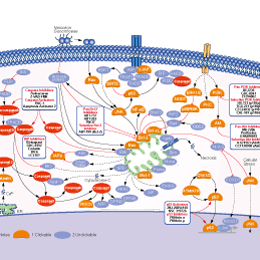
- Bioactive Compounds
- By Signaling Pathways
- PI3K/Akt/mTOR
- Epigenetics
- Methylation
- Immunology & Inflammation
- Protein Tyrosine Kinase
- Angiogenesis
- Apoptosis
- Autophagy
- ER stress & UPR
- JAK/STAT
- MAPK
- Cytoskeletal Signaling
- Cell Cycle
- TGF-beta/Smad
- DNA Damage/DNA Repair
- Compound Libraries
- Popular Compound Libraries
- Customize Library
- Clinical and FDA-approved Related
- Bioactive Compound Libraries
- Inhibitor Related
- Natural Product Related
- Metabolism Related
- Cell Death Related
- By Signaling Pathway
- By Disease
- Anti-infection and Antiviral Related
- Neuronal and Immunology Related
- Fragment and Covalent Related
- FDA-approved Drug Library
- FDA-approved & Passed Phase I Drug Library
- Preclinical/Clinical Compound Library
- Bioactive Compound Library-I
- Bioactive Compound Library-Ⅱ
- Kinase Inhibitor Library
- Express-Pick Library
- Natural Product Library
- Human Endogenous Metabolite Compound Library
- Alkaloid Compound LibraryNew
- Angiogenesis Related compound Library
- Anti-Aging Compound Library
- Anti-alzheimer Disease Compound Library
- Antibiotics compound Library
- Anti-cancer Compound Library
- Anti-cancer Compound Library-Ⅱ
- Anti-cancer Metabolism Compound Library
- Anti-Cardiovascular Disease Compound Library
- Anti-diabetic Compound Library
- Anti-infection Compound Library
- Antioxidant Compound Library
- Anti-parasitic Compound Library
- Antiviral Compound Library
- Apoptosis Compound Library
- Autophagy Compound Library
- Calcium Channel Blocker LibraryNew
- Cambridge Cancer Compound Library
- Carbohydrate Metabolism Compound LibraryNew
- Cell Cycle compound library
- CNS-Penetrant Compound Library
- Covalent Inhibitor Library
- Cytokine Inhibitor LibraryNew
- Cytoskeletal Signaling Pathway Compound Library
- DNA Damage/DNA Repair compound Library
- Drug-like Compound Library
- Endoplasmic Reticulum Stress Compound Library
- Epigenetics Compound Library
- Exosome Secretion Related Compound LibraryNew
- FDA-approved Anticancer Drug LibraryNew
- Ferroptosis Compound Library
- Flavonoid Compound Library
- Fragment Library
- Glutamine Metabolism Compound Library
- Glycolysis Compound Library
- GPCR Compound Library
- Gut Microbial Metabolite Library
- HIF-1 Signaling Pathway Compound Library
- Highly Selective Inhibitor Library
- Histone modification compound library
- HTS Library for Drug Discovery
- Human Hormone Related Compound LibraryNew
- Human Transcription Factor Compound LibraryNew
- Immunology/Inflammation Compound Library
- Inhibitor Library
- Ion Channel Ligand Library
- JAK/STAT compound library
- Lipid Metabolism Compound LibraryNew
- Macrocyclic Compound Library
- MAPK Inhibitor Library
- Medicine Food Homology Compound Library
- Metabolism Compound Library
- Methylation Compound Library
- Mouse Metabolite Compound LibraryNew
- Natural Organic Compound Library
- Neuronal Signaling Compound Library
- NF-κB Signaling Compound Library
- Nucleoside Analogue Library
- Obesity Compound Library
- Oxidative Stress Compound LibraryNew
- Plant Extract Library
- Phenotypic Screening Library
- PI3K/Akt Inhibitor Library
- Protease Inhibitor Library
- Protein-protein Interaction Inhibitor Library
- Pyroptosis Compound Library
- Small Molecule Immuno-Oncology Compound Library
- Mitochondria-Targeted Compound LibraryNew
- Stem Cell Differentiation Compound LibraryNew
- Stem Cell Signaling Compound Library
- Natural Phenol Compound LibraryNew
- Natural Terpenoid Compound LibraryNew
- TGF-beta/Smad compound library
- Traditional Chinese Medicine Library
- Tyrosine Kinase Inhibitor Library
- Ubiquitination Compound Library
-
Cherry Picking
You can personalize your library with chemicals from within Selleck's inventory. Build the right library for your research endeavors by choosing from compounds in all of our available libraries.
Please contact us at [email protected] to customize your library.
You could select:
- Antibodies
- Bioreagents
- qPCR
- 2x SYBR Green qPCR Master Mix
- 2x SYBR Green qPCR Master Mix(Low ROX)
- 2x SYBR Green qPCR Master Mix(High ROX)
- Protein Assay
- Protein A/G Magnetic Beads for IP
- Anti-Flag magnetic beads
- Anti-Flag Affinity Gel
- Anti-Myc magnetic beads
- Anti-HA magnetic beads
- Magnetic Separator
- Poly DYKDDDDK Tag Peptide lyophilized powder
- Protease Inhibitor Cocktail
- Protease Inhibitor Cocktail (EDTA-Free, 100X in DMSO)
- Phosphatase Inhibitor Cocktail (2 Tubes, 100X)
- Cell Biology
- Cell Counting Kit-8 (CCK-8)
- Animal Experiment
- Mouse Direct PCR Kit (For Genotyping)
- New Products
- Contact Us
Belnacasan (VX-765)
Belnacasan (VX-765) is a potent and selective inhibitor of caspase-1 with Ki of 0.8 nM in a cell-free assay. Phase 2.
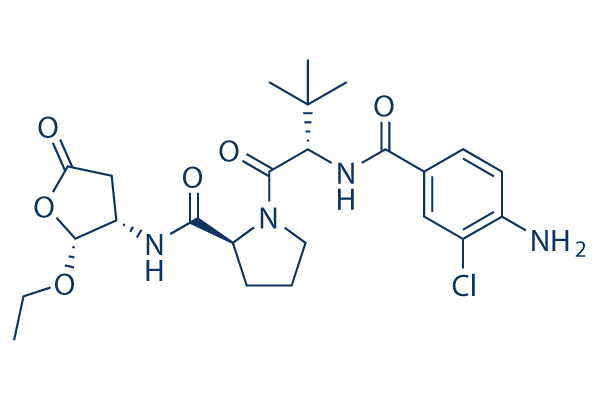
Belnacasan (VX-765) Chemical Structure
CAS No. 273404-37-8
Purity & Quality Control
Batch:
Purity:
99.99%
99.99
Belnacasan (VX-765) Related Products
| Related Targets | Caspase-1 Caspase-3 Caspase-8 Caspase-9 Caspase-4 Capase-7 Caspase-2 Caspase-5 Caspase-6 Caspase-10 Caspase-7 | Click to Expand |
|---|---|---|
| Related Products | Z-VAD-FMK Z-DEVD-FMK Q-VD-Oph Z-IETD-FMK Emricasan (IDN-6556) Ac-DEVD-CHO Z-LEHD-FMK TFA Z-VAD(OH)-FMK (Caspase Inhibitor VI) PAC-1 Z-YVAD-FMK Apoptosis Activator 2 Tasisulam Phenoxodiol (Haginin E) | Click to Expand |
| Related Compound Libraries | Autophagy Compound Library Apoptosis Compound Library Ferroptosis Compound Library Pyroptosis Compound Library Mitochondria-Targeted Compound Library | Click to Expand |
Signaling Pathway
Biological Activity
| Description | Belnacasan (VX-765) is a potent and selective inhibitor of caspase-1 with Ki of 0.8 nM in a cell-free assay. Phase 2. | ||||
|---|---|---|---|---|---|
| Features | A potent and selective inhibitor of interleukin-converting enzyme/caspase-1. | ||||
| Targets |
|
| In vitro | ||||
| In vitro | VX-765 is an orally absorbed prodrug of VRT-043198, which exhibits potent inhibition against ICE/caspase-1 and caspase-4 with Ki of 0.8 nM and less than 0.6 nM, respectively. And VRT-043198 also inhibits IL-1β release from both PBMCs and whole blood with IC50 of 0.67 μM and 1.9 μM, respectively. [1] |
|||
|---|---|---|---|---|
| Kinase Assay | Protease Enzyme Assays | |||
| Enzyme inhibition is assayed by tracking of the rate of hydrolysis of an appropriate substrate labeled with either p-nitroaniline or aminomethyl coumarin (AMC) as follows: ICE/caspase-1, suc-YVAD-p-nitroanilide; caspase-4, Ac-WEHD-AMC; caspase-6, Ac-VEID-AMC; caspase-3, -7, -8, and -9, Ac-DEVD-AMC; and granzyme B, Ac-IEPD-AMC. Enzymes and substrates are incubated in a reaction buffer [10 mM Tris, pH 7.5, 0.1% (w/v) CHAPS, 1 mM dithiothreitol, and 5% (v/v) dimethyl sulfoxide] for 10 minutes at 37 °C. Glycerol is added to the buffer at 8% (v/v) for caspase-3, -6, and -9 and granzyme B to improve stability of enzymes. The rate of substrate hydrolysis is monitored using a fluorometer | ||||
| Cell Research | Cell lines | PBMCs | ||
| Concentrations | 0.7 µM | |||
| Incubation Time | 30 minutes | |||
| Method | PBMCs were pre-treated with VX-765 for 30 minutes before exposure to LPS. |
|||
| Experimental Result Images | Methods | Biomarkers | Images | PMID |
| Western blot | Bax / Bcl-2 / caspase-3 / caspase-1 / caspase-11 / GSDMD-N / GAPDH Cyto c / Tubulin Bid / tBid / Tubulin |
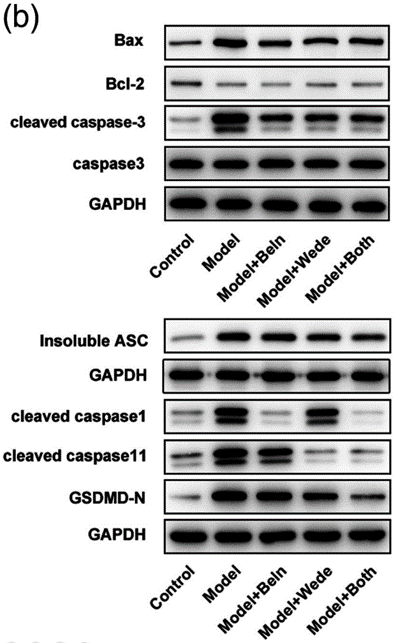
|
32865056 | |
| IHC | HE staining / TUNEL |
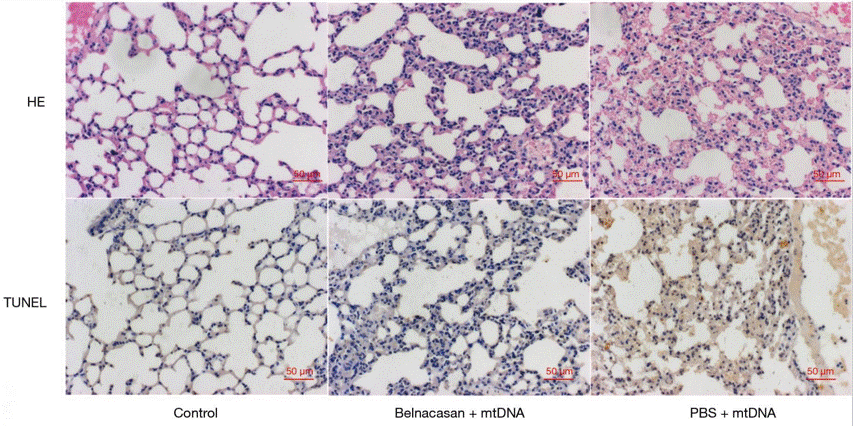
|
31903272 | |
| Immunofluorescence | GSDMD-NT |
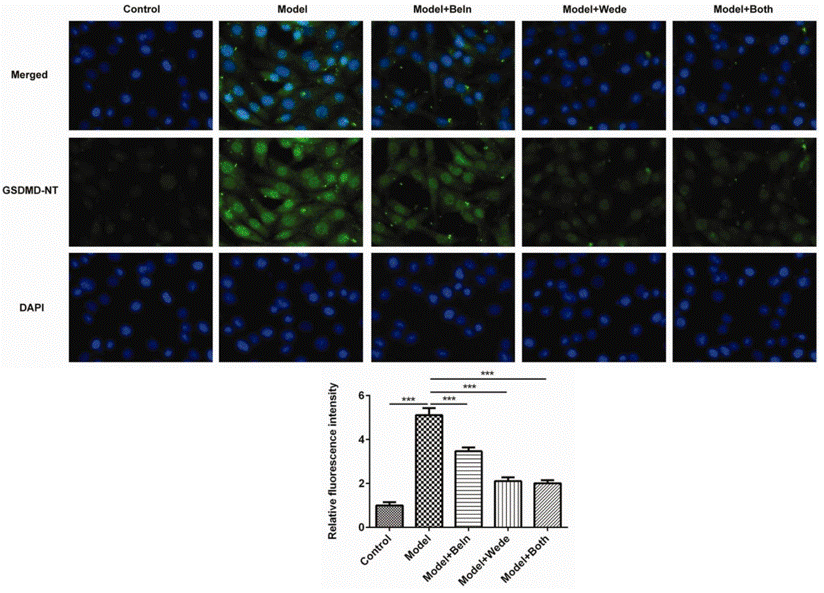
|
32865056 | |
| In Vivo | ||
| In vivo | In collagen-induced arthritis mouse model, VX-765 (200 mg/kg) inhibits LPS-induced IL-1β production by about 60%, and results in a dose-dependent, statistically significant reduction in the inflammation scores and effective protection from joint changes. [1] In vivo, VX-765 blocks kindling epileptogenesis in rats by preventing IL-1β increase in forebrain astrocytes without significant effect on afterdischarge duration. [2] In the mouse model of acute seizures, VX-765 (50 mg/kg-200 mg/kg) produces the anticonvulsant effect by delaying the time to onset of the first seizure and decreasing the number of seizures as well as their total duration by average 50% and 64%. [3] In adult rats with genetic absence epilepsy (GAERS), VX-765, after the 3rd drug injection, significantly reduces the cumulative duration and number of spike-and-wave discharges (SWDs) by 55% on average by selectively blocking IL-1β biosynthesis. [4] |
|
|---|---|---|
| Animal Research | Animal Models | Collagen-induced arthritis mouse model. |
| Dosages | ≤200 mg/kg | |
| Administration | Administered via p.o. | |
| NCT Number | Recruitment | Conditions | Sponsor/Collaborators | Start Date | Phases |
|---|---|---|---|---|---|
| NCT01501383 | Terminated | Epilepsy |
Vertex Pharmaceuticals Incorporated |
December 2011 | Phase 2 |
Chemical Information & Solubility
| Molecular Weight | 509 | Formula | C24H33ClN4O6 |
| CAS No. | 273404-37-8 | SDF | Download Belnacasan (VX-765) SDF |
| Smiles | CCOC1C(CC(=O)O1)NC(=O)C2CCCN2C(=O)C(C(C)(C)C)NC(=O)C3=CC(=C(C=C3)N)Cl | ||
| Storage (From the date of receipt) | |||
|
In vitro |
DMSO : 100 mg/mL ( (196.46 mM) Moisture-absorbing DMSO reduces solubility. Please use fresh DMSO.) Ethanol : 100 mg/mL Water : Insoluble |
Molecular Weight Calculator |
|
In vivo Add solvents to the product individually and in order. |
In vivo Formulation Calculator |
|||||
Preparing Stock Solutions
Molarity Calculator
In vivo Formulation Calculator (Clear solution)
Step 1: Enter information below (Recommended: An additional animal making an allowance for loss during the experiment)
mg/kg
g
μL
Step 2: Enter the in vivo formulation (This is only the calculator, not formulation. Please contact us first if there is no in vivo formulation at the solubility Section.)
% DMSO
%
% Tween 80
% ddH2O
%DMSO
%
Calculation results:
Working concentration: mg/ml;
Method for preparing DMSO master liquid: mg drug pre-dissolved in μL DMSO ( Master liquid concentration mg/mL, Please contact us first if the concentration exceeds the DMSO solubility of the batch of drug. )
Method for preparing in vivo formulation: Take μL DMSO master liquid, next addμL PEG300, mix and clarify, next addμL Tween 80, mix and clarify, next add μL ddH2O, mix and clarify.
Method for preparing in vivo formulation: Take μL DMSO master liquid, next add μL Corn oil, mix and clarify.
Note: 1. Please make sure the liquid is clear before adding the next solvent.
2. Be sure to add the solvent(s) in order. You must ensure that the solution obtained, in the previous addition, is a clear solution before proceeding to add the next solvent. Physical methods such
as vortex, ultrasound or hot water bath can be used to aid dissolving.
Tech Support
Answers to questions you may have can be found in the inhibitor handling instructions. Topics include how to prepare stock solutions, how to store inhibitors, and issues that need special attention for cell-based assays and animal experiments.
Tel: +1-832-582-8158 Ext:3
If you have any other enquiries, please leave a message.
* Indicates a Required Field
Frequently Asked Questions
Question 1:
The recommended dose of VX-765 is 100mg/kg p.o. in 25% cremophor EL in water. Is VX0765 directly soluble at 10mg/ml in 25% cremophor in water? How to formulate it for in vivo use in mice?
Answer:
You can prepare 25% cremophor EL in water first and then directly resuspend VX-765 powder in the vehicle. The powder may not be fully dissolved, but the suspension is stable and can be used for gavage feeding.
Tags: buy Belnacasan (VX-765) | Belnacasan (VX-765) supplier | purchase Belnacasan (VX-765) | Belnacasan (VX-765) cost | Belnacasan (VX-765) manufacturer | order Belnacasan (VX-765) | Belnacasan (VX-765) distributor







































